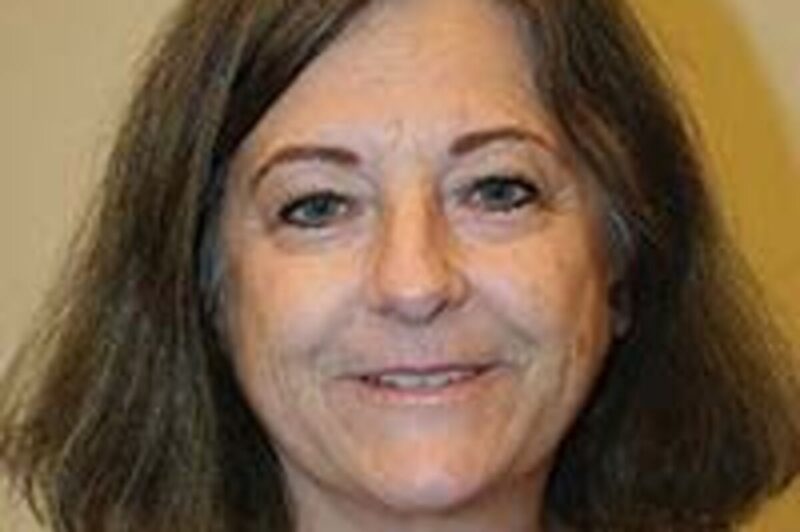Community involvement has long been part of Sharon Kanareff’s life, and it’s one of the reasons she has a new job: to head the effort to develop a community forest and a riverside trail east of Sweet Home.
Kanareff, who is in her “late 50s,” has been named coordinator for the South Santiam All Lands Collaborative, whose goals are to establish the community forest and plan and implement a South Santiam River Trail and improve livability and quality of life in East Linn County, primarily through the federal Livability Initiative recently conducted for Sweet Home.
Her hiring comes almost exactly a year after participants in a Governor’s Solutions Team signed a declaration of cooperation to establish a community forest corridor from Sweet Home to the Willamette National Forest boundary east of Cascadia last March.
The goal of establishing the community forest is to “reconnect” Sweet Home visitors and residents with the “natural world” while “respecting the rights and values of landowners” and focus on capitalizing on “win-win” opportunities to coordinate management of public and private forests, generate forest products and create opportunities for recreation and conservation education.
The document signed last year describes the potential location of the forest as extending from the site of the former Western States Reliance Trust land that begins immediately north of the Sweet Home police station and Bi-Mart, which borders the site of a proposed future park, east along the river to the former site of the Triple T mill, on the east end of Cascadia, then on to Gordon Road and the Willamette National Forest. It would include Cascadia Cave, east of Cascadia State Park. A trail running the length of the community forest is a significant component of the project.
SSALC, a cooperative effort between local government, private industry and public land agencies that began in 2012, has been designated the interim governing body for the South Santiam Community Forest effort. A fairly unique mix of public and private land management entities, its major players are the U.S. Forest Service, Linn County and Cascade Timber Consulting.
Kanareff comes from Toledo, where she most recently has worked as a community relations manager for Georgia Pacific. Previously, she worked for 16 years in Washington state for Alcoa, the aluminum producer, as a lobbyist and community relations organizer.
“Most of my time at Alcoa was spent working with local leaders, teaching (company officials) how to be valuable parts of their community,” she said. “With an aluminum smelter and mill, you have to have community consent to operate. If you’re not part of that community, if you don’t embed yourself in that community, you don’t have the right to be there.”
She said she helped company executives, who tend to move frequently from one community to another, to understand community needs such as hunger, housing and education.
“They need to know how to be part of that community,” Kanareff said.
She was born and raised in Cleveland, Ohio. Her father was a city engineer, so she had early exposure to public affairs, she said.
She earned degrees in journalism and English from the University of Washington – punctuated by a year-long break after her freshman year, in 1975.
“I cashed in my tuition check and took a train across Canada to the Winter Festival in Quebec,” she said. “I’d always wanted to go to the Winter Festival.”
The 1976 Summer Olympics were being held in Montreal, so she stopped there and got a job in a restaurant.
“I worked at the Olympics and took junior college courses. I got almost all of my humanities courses out of the way there.”
After college, she worked in the White House Office of Management and Budget for several years before becoming press secretary for U.S. Sen. Slade Gorton of Washington state.
Later, in the mid-1990s, she owned and operated a fishing and natural history tour company in Healy, Alaska, outside of Denali National Park before going to work in the aluminum industry.
“I’ve been in public affairs, I’ve done community outreach work, foundation work, community organization and lots of media,” Kanareff said. “I’ve done a little bit of this, a little bit of that.”
She said she was attracted to the SHALC position, which is currently only funded for one year, because “I wanted to find a community that I could move to and be a part of and not be representing something large, but really join the community in building something.”
As coordinator for the community forest project, Kanareff will formulate proposals and figure out how to structure the effort, which is the result of a collaborative effort by “well-meaning agencies,” said Sweet Home City Manager Craig Martin, one of the original organizers of SHALC. He said she was one of “a very strong pool of candidates” who applied for the position.
“Even though we only have funding for one year, we drew some pretty strong candidates, which, I think, is indicative of the desire for what we’re trying to operate – a collaborative versus single agencies,” Martin said. “A lot of people wanted to work in that kind of environment because they see that as the new way of doing land management across multiple jurisdictions.”
Kanareff’s position is being funded initially by a $50,000 grant from the Roseburg-based Ford Family Foundation, which aims to support “successful citizens and vital rural communities” in Oregon and northern California.
An additional $10,000 is being provided by Linn County, with $5,000 more coming from the City of Sweet Home. She will actually be employed by the nonprofit South Santiam Watershed Council, which is based at the U.S. Forest Service Sweet Home Ranger District headquarters, and will report to its newly appointed coordinator, Eric Anderson. Both of them will have offices at the Sweet Home Ranger District headquarters.
Kanareff will also receive direction from the SHALC board, which includes representatives of a variety of the members of the collaborative, Martin said. Those include the U.S. Forest Service, Linn County, the U.S. Army Corps of Engineers, the City of Sweet Home, CTC, the Sweet Home Trails group, the Oregon State University College of Forestry, the University of Oregon Institute for Sustainable Forestry and the watershed council.
Martin said he sees a lot of similarities between Kanareff’s position and Sweet Home’s recent RARE position, which was hosted by the city but benefited the Governor’s Solution Team effort.
Kanareff said this job will be new in a lot of ways.
“The position was attractive to me because there have been so many people involved in envisioning this, and I want to take their vision that everybody’s been working on part-time and really focus my full-time attention on it to bring this to reality.”
She said she believes her board work, which includes writing grant applications for the Children’s Development Network, an effort to address high-poverty issues among pre-kindergarten children in Lincoln County, will be helpful in her new job. She also has done “a lot of work” with the Chelan-Douglas Land Trust on its regional trails system in Washington state.
“I have some experience – I wouldn’t call it extensive – with the kinds of work that goes into trying to create what the folks here are envisioning,” she said.
“I think the biggest hurdles are going to be producing results,” she said. “There’s been a lot of effort spent on vision and the proof is going to be on the ground. And that’s the biggest challenge I’m gonna face with getting the organization together and getting something on the ground. There hasn’t been a community forest put together yet, as far as I can tell, in the state. That’s part of what’s going to be the excitement and the challenge.”





